(above: an African Bull-Frog. I love this picture – although I suspect in this Poe tale, it more resembles the King than Hop-Frog!)
What is a punishment suitable for a king? And I don’t mean a good and benevolent king, but one who “…does not scruple to strike a defenseless girl?” (and the punishment must also serve for his seven ministers who “abet him in the outrage”) Leave the answer to Edgar Allan Poe, and his character, Hop-Frog, via whom the punishment is dealt…
(below: I found a lot of great, old illustrations for this story on-line; most were not spoiler-free, but the three I included are. 🙂 )
The story “Hop-Frog” was first published in 1849. I was familiar with it only by means of its curious title, which I had heard mentioned multiple times over the years. Yesterday morning, curiosity finally won out, and I opened my e-book, “The Complete Works of Edgar Allan Poe”…
Poe begins with some brief history about the tradition of court jesters or “fools” and also speculates on why, apparently, most humorous men are fat men. “Whether people grow fat by joking, or whether there is something in fat itself which predisposes to a joke, I have never been quite able to determine; but certain it is that a lean joker is a rara avis in terris.” Certainly at this time of year, there is one certain public figure which provides evidence in favor of this observation.
But back to the story… The hapless “Hop-Frog” has the misfortune of being a jester for a thoughtless and cruel king. Captured from his homeland, along with the sweet girl, Tripetta, who was “very little less drawfish (than Hop-Frog) although of exquisite proportions, and a marvelous dancer,” Hop-Frog lives out a persecuted existence in the king’s service. He earned his name from only being able to “get along by a sort of intersectional gait – something between a leap and a wriggle – a movement which provided illimitable amusement… to the king” The silver lining to his condition, though, was “the prodigious muscular power which nature seemed to have bestowed upon his arms, by way of compensation for deficiency in his lower limbs,” which “enabled him to perform many feats of wonderful dexterity, where trees or ropes were in question, or anything else to climb.” This proves to be a valuable skill in this story, which becomes one of revenge.
The stage is set when the king begins planning a great pageant of masquerade entertainment and wants suggestions from his dwarf. When they are not quickly provided, the king forces Hop-Frog to drink wine to “make him merry” so that humorous ideas will be more quickly forthcoming.
Hop-Frog hates to drink due to the ease with which he is overcome by alcohol. Tripetta knows this, and attempts to intercede when a second drink is about to be forced upon the dwarf. For her trouble, she is thrown violently to the ground, and – amid laughter – the goblet of wine dashed in her face.
Seeing his only friend treated thus, Hop-Frog seemingly remains calm, but the beast has been awakened. He skillfully plots his revenge, beginning by suggesting the king and his ministers take for their part in the masquerade a jest from his own country, called “The Eight Chained Ourang-outangs.” They eagerly agree, and so their fate is set…
Read the story on-line at: http://classiclit.about.com/library/bl-etexts/eapoe/bl-eapoe-hop.htm I now count it a new favorite among his many, many great stories. Not as well-known as his most famous dozen or so, but of equal merit in this reader’s opinion.
Other Poe on this blog:
The Facts in the Case of M. Valdemar
The Narrative of Arthur Gordon Pym of Nantucket
And – for the trivia points: what is it with Poe and Orangutans? I’ve just – for a book discussion in a couple weeks – finished another famous story of his where they play a prominent role – do you know which one I’m talking about?? 🙂
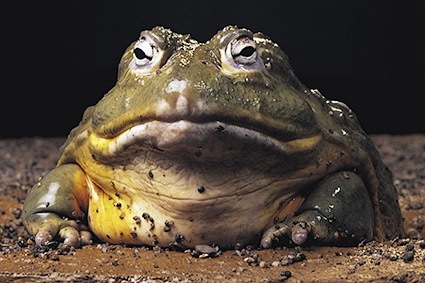
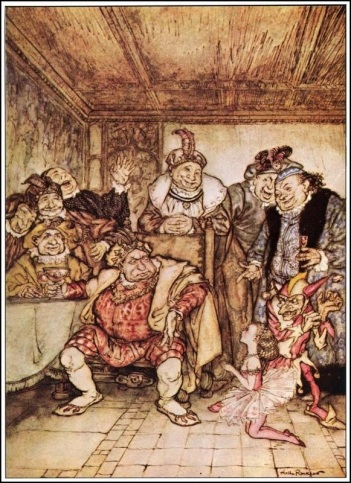
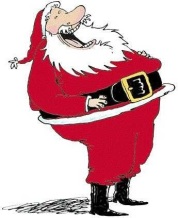

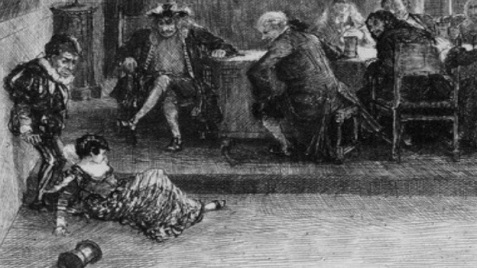
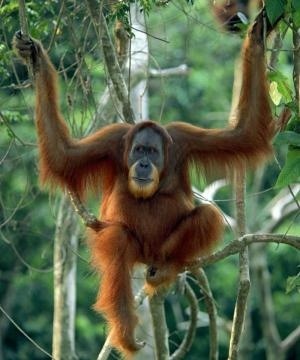
Dee said,
December 2, 2013 at 10:24 am
Hi Jay ……
I must have read this story 40 years ago and the shocking ending has stayed with me all this time! What a masterpiece of imagination and calculated suspense …… I forgot about Tripetta’s role – shall re-read soon. And no, to your end question.
LikeLike
Jay said,
December 3, 2013 at 8:38 am
Hi Dee,
Thanks for the comment – I love to hear about it when a post of mine has jostled memories of long ago reading. :-). I agree the story is a masterpiece, and your comment of calculated SUSPENSE can have a couple meanings here, can’t it? 🙂
-Jay
LikeLike
Acid Free Pulp said,
December 2, 2013 at 4:01 pm
I don’t know what his deal is with orangutans. He was always inspired by real events or true crimes. Could there have been a zoo exhibition around the time of when he wrote Murders in the Rue Morgue?? I’m sure seeing certain exotic beasts weren’t as easy to come by back then.
LikeLike
Jay said,
December 3, 2013 at 8:40 am
Congrats on winning the trivia points! 🙂 I wondered if Orangutans were a “public sensation” in Poe’s time too. I know they were first discovered a hundred or so years earlier, but maybe they didn’t become generally known until the mid-19th century(?)
LikeLike
Acid Free Pulp said,
December 3, 2013 at 9:55 am
On Wikipedia, the citation lists a book about Poe (ISBN 978-0-8154-1038-6) stating that he could have been inspired by a reaction from a crowd in Philadelphia where an orangutan was displayed in 1839. So it sounds like what you proffered–a rare sight to see, indeed!
LikeLike
Jay said,
December 3, 2013 at 10:02 am
There is also the “intrigue” of their once being referred to as the “wild man of borneo -which perhaps implies a sentient nature as well. I think I may have to do some orangutan research too – I’m afraid Dr. Zaius is about the current extent of my orangutan knowledge…
LikeLike
Wick said,
December 2, 2013 at 9:30 pm
Hop-frog remains one of the most memorable short stories I ever read.
LikeLike
Jay said,
December 3, 2013 at 8:42 am
Hi Wick,
I thought it was quite powerful. Poe somehow easily got me to feel the anguish of Hop-Frog’s situation – to the point that his barbaric act of revenge didn’t even bother me. It will stick with me for a long time as well.
-Jay
LikeLike
Tomo said,
December 3, 2013 at 1:43 am
I enjoyed reading the Poe collection during my Freshman Year of High School. “Hop-Frog” was one I did particularly like.
The Orangutan story that you make reference to, Jay, is considered one of the first Detective stories ever written.
LikeLike
Jay said,
December 3, 2013 at 8:45 am
Hi Tomo,
I would’ve liked to have been Ina high school class that read that story! I bet the discussions were interesting…
You’re right about Poe’s “Dupin” stories, too. The Murders in the Rue Morgue and The Purloined Letter showcased the deductive powers that later made Sherlock Holmes such a sensation.
-Jay
LikeLike